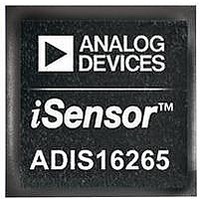ADIS16265BCCZ Analog Devices Inc, ADIS16265BCCZ Datasheet - Page 9

ADIS16265BCCZ
Manufacturer Part Number
ADIS16265BCCZ
Description
IC SENSOR GYRO PROGR 10MV 20LGA
Manufacturer
Analog Devices Inc
Series
MEMSr
Datasheet
1.ADIS16260PCBZ.pdf
(20 pages)
Specifications of ADIS16265BCCZ
Range °/s
±80°/s, ±160°/s, ±320°/s
Sensitivity
±0.2%
Typical Bandwidth
50Hz
Voltage - Supply
4.75 V ~ 5.25 V
Current - Supply
41mA
Output Type
Digital
Operating Temperature
-40°C ~ 105°C
Package / Case
20-LGA
No. Of Axes
1
Sensor Case Style
LGA
No. Of Pins
20
Supply Voltage Range
4.75V To 5.25V
Operating Temperature Range
-40°C To +105°C
Msl
MSL 5 - 48 Hours
Termination Type
SMD
Acceleration Range
2000g
Filter Terminals
SMD
Digital Ic Case Style
LGA
Lead Free Status / RoHS Status
Lead free / RoHS compliant by exemption
Available stocks
Company
Part Number
Manufacturer
Quantity
Price
Company:
Part Number:
ADIS16265BCCZ
Manufacturer:
TOSHIBA
Quantity:
928
THEORY OF OPERATION
The ADIS16260 and ADIS16265 integrate a MEMS gyroscope
with data sampling, signal processing, and calibration functions,
along with a simple user interface. This sensing system collects
data autonomously and makes it available to any processor system
that supports a 4-wire serial peripheral interface (SPI).
SENSING ELEMENT
The sensing element operates on the principle of a resonator
gyro. Two polysilicon sensing structures each contain a dither
frame that is electrostatically driven to resonance, producing
the necessary velocity element to produce a Coriolis force
during angular rate. At two of the outer extremes of each frame,
orthogonal to the dither motion, movable fingers are placed
between fixed pickoff fingers to form a capacitive pickoff
structure that senses Coriolis motion. The resulting signal is fed
into a series of gain and demodulation stages that produce the
electrical rate signal output. The differential structure minimizes
the response to linear acceleration (gravity, vibration, and so
on) and to EMI.
DATA SAMPLING AND PROCESSING
The ADIS16260 and ADIS16265 run autonomously, based on
the configuration in the user control registers. The analog
gyroscope signal feeds into an analog-to-digital converter
(ADC) stage, which passes digitized data into the controller for
data processing and register loading. Data processing in the
embedded controller includes correction formulas, filtering,
and checking for preset alarm conditions. The correction formulas
are unique for each individual ADIS16260/ADIS16265 and come
from the factory characterization of each device over a
temperature range of −40°C to +85°C.
SIGNALS
SENSOR
SENSOR
MEMS
TEMP
AIN
Figure 7. Simplified Sensor Signal Processing Diagram
CLOCK
ADC
CONTROLLER
REGISTERS
REGISTERS
CONTROL
OUTPUT
Rev. B | Page 9 of 20
USER INTERFACE
SPI Interface
Data collection and configuration commands both use the SPI,
which consists of four wires. The chip select ( CS ) signal activates
the SPI interface, and the serial clock (SCLK) signal synchronizes
the serial data lines. The serial input data clocks into DIN on
the SCLK rising edge, and the serial output data clocks out of
DOUT on the SCLK falling edge. Many digital processor plat-
forms support this interface with dedicated serial ports and
simple instruction sets.
User Registers
The user registers provide addressing for all input/output
operations on the SPI interface. Each 16-bit register has its
own unique bit assignment and has two 7-bit addresses: one
for its upper byte and one for its lower byte. Table 7 provides
a memory map of the user registers, along with the function of
each register.
The control registers use a dual memory structure. The SRAM
controls operation while the part is on and facilitates all user
configuration inputs. The flash memory provides nonvolatile
storage for control registers that have flash backup (see Table 7).
Storing configuration data in the flash memory requires a separate
command (GLOB_CMD[3] = 1, DIN = 0xBE08). When the
device powers on or resets, the flash memory contents are
loaded into the SRAM, and the device then starts producing
data according to the configuration in the control registers.
(NO SPI ACCESS)
FLASH MEMORY
NONVOLATILE
Figure 8. SRAM and Flash Memory Diagram
OR RESET
STARTUP
MANUAL
BACKUP
ADIS16260/ADIS16265
FLASH
SPI ACCESS
VOLATILE
SRAM













